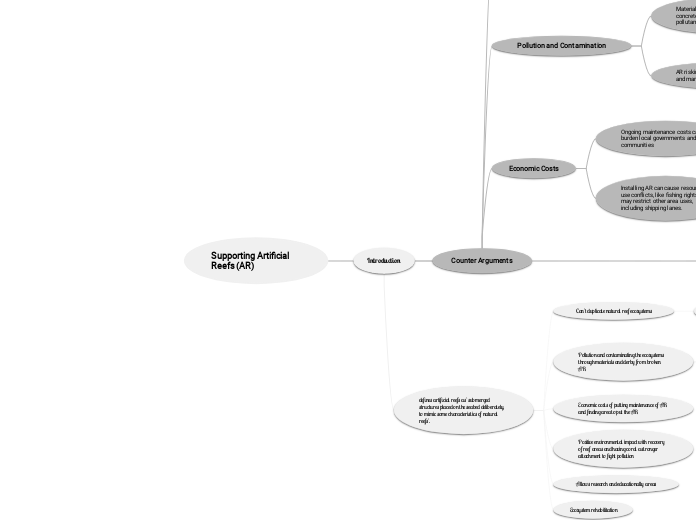Supporting Artificial Reefs (AR)
Introduction
defines artificial reefs as `submerged structures placed on the seabed deliberately, to mimic some characteristics of natural reefs'.
Can't duplicate natural reef ecosystems
Can exceed Biological abiotic and biotic factors
Pollution and contaminating the ecosystems through materials and derby from broken AR
Using friendly disposal methods
Have on going maintenance to decrease
Economic costs of putting maintenance of AR and finding area to put the AR
Positive environmental impact with recovery of reef areas and having coral a stronger attachment to fight pollution
Allows research and educationally areas
Ecosystem rehabilitation
Counter Arguments
Environmental Impact
AR often can't fully replicate the complexity and biodiversity of natural reef ecosystems.
Fish pop., biomass, & diversity rebounded to levels like/exceeding untouched reef flats.
Pollution and Contamination
Materials in artificial reefs, like concrete or metals, may release pollutants, harming marine life.
Using old ships, oil rigs, or structures as reefs is a cost-effective, eco-friendly disposal method.
AR risking harm to the structures and marine environment.
AR have ongoing maintenance, Natural reefs can also be damaged by humans, storms, or other factors.
Economic Costs
Ongoing maintenance costs can burden local governments and communities
AR attract tourists, divers, and anglers, boosting the local economy through increased tourism revenue.
Installing AR can cause resource use conflicts, like fishing rights, and may restrict other area uses, including shipping lanes.
AR act as nurseries and feeding grounds, boosting fish populations and benefiting local fisheries, economically helping coastal communities.
My Arguments
Environmental Impact
We can deduce that the widespread implementation of AR has become increasingly vital in expediting the recovery of reefs.
Provides stronger attachments for corals
Research and Education
AR serve as educational tools for schools and research labs for marine scientists, promoting marine ecology research and conservation education."
Ecosystem Rehabilitation
AR have seen successful and robust coral recruitment in areas previously affected by significant coral mortality
These AR deter trawling creating new habitats for various plants and animals, and benefiting fisheries management.
Conclusion
Exposition
Rising action
Literature
Abelson, A. (2006). Artificial reefs vs coral transplantation as restoration tools for mitigating. coral reef deterioration: benefits, concerns, and proposed guidelines. Bulletin of Marine Science, Volume 78(Issue 1), 151-159(9). https://www.ingentaconnect.com/content/umrsmas/bullmar/2006/00000078/00000001/art00013#
Clark, S., Edwards, A. J. (1999). An evaluation of artificial reef structures as tools for marine habitat rehabilitation in the Maldives. Aquatic Conservation: Marine and Freshwater Ecosystems, Volume 9(Issue 1), 5-21. https://doi.org/10.1002/(SICI)1099-0755(199901/02)9:1<5::AID-AQC330>3.0.CO;2-U
Cited in CA - Environmental impacts and MA - Environmental impacts
Fadli, N., Campbell, S., Ferguson, K., & et al. (2012). The role of habitat creation in coral reef conservation: A case study from Aceh, Indonesia. Oryx, Volume 46(Issue 4), 501-507. doi:10.1017/S0030605312000142
Research and Education, Ecosystem Rehabilitation
Ferse, S. C. A. (2008). Artificial reef structures and coral transplantation fish community responses and effects on coral recruitment in North Sulawesi, Indonesia. Center for Tropical Marine Ecology. https://www.researchgate.net/profile/Sebastian-Ferse/publication/27336288_Artificial_reef_structures_and_coral_transplantation_fish_community_responses_and_effects_on_coral_recruitment_in_North_SulawesiIndonesia/links/0a85e530e58ed9dc9b000000/Artificial-reef-structures-and-coral-transplantation-fish-community-responses-and-effects-on-coral-recruitment-in-North-Sulawesi-Indonesia.pdf
Higgins, E. Mataxas, A., & Scheibling, E. R. (2022). A systematic review of artificial reefs as platforms for coral reef research and conservation. https://doi.org/10.1371/journal.pone.0261964
Ecosystem Rehabilitation
Kirkbride-Smith, E. A. (2014) The economic, social and conservation benefits of recreation-orientated artificial reefs. file:///C:/Users/Alogt/Downloads/content-hull_11669a%20(1).pdf
Research and Education, Ecosystem Rehabilitation
Layman, C. A., Allgeier, J. E. (2020). An ecosystem ecology perspective on artificial reef production. Journal of Applied Ecology, Volume 57(Issue 11), 2139-2148. https://doi.org/10.1111/1365-2664.13748
Environmental impacts
Pickering, H., Whitmarsh, D., & Jensen, A. (1999). Artificial reefs as a tool to aid rehabilitation of coastal ecosystems: Investigating the potential. Marine Pollution Bulletin, Volume 37(Issues 8–12), 505-514. https://doi.org/10.1016/S0025-326X(98)00121-0
Introduction, Ecosystem Rehabilitation
Raj, K.D., Mathews, G. & Edward, J.K.P. (2020). Long-term benefits of artificial reef modules for reef recovery in gulf of Mannar. Southeast India. J Coast Conserv 24, 53. https://doi.org/10.1007/s11852-020-00773-5
Ecosystem Rehabilitation, MA - Environmental impacts
Sutton, G. S., Bushnell L. S. (2007). Socio-economic aspects of artificial reefs: Considerations for the great barrier reef marine park. Ocean & Coastal Management, Volume 50(Issue 10), 829-846. https://doi.org/10.1016/j.ocecoaman.2007.01.003.
Pollution and Economics
